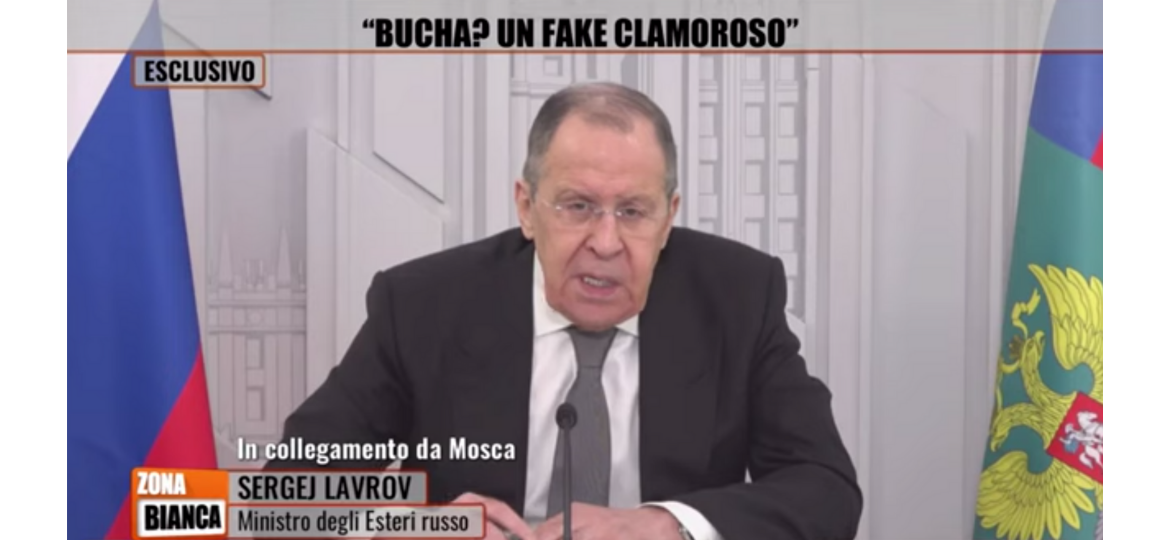This article has been originally published on Facta News the 2nd of May 2022
Russian Foreign Minister Sergej Lavrov, on May 1, was interviewed by an Italian tv show, Zona Bianca (Rete 4), about the situation in Ukraine. Lavrov reiterated several arguments of Russian propaganda, some of which are demonstrably false.
Relying on the simultaneous translation in Italian provided during the broadcast, we have focused here on Lavrov’s statements about three main topics — in particular: on the objectives of the Russian invasion, on the ‘Nazi’ nature of Ukraine, and on the truth about the massacre of Bucha — and we have linked several fact-checking articles already published in the past weeks that demonstrate their falselyhood.
Russia is hitting only military infrastructure
Lavrov argued (min. 7: 48) that the objectives of the ‘Special Operation’ — like Moscow propaganda is describing the invasion of Ukraine — were ‘the military infrastructure in Ukraine’ that were used to oppress the civilian population in the east of Ukraine and that ‘were also a threat to the Russian Federation’.
The destruction of civilian targets by the Russian army — in some cases the destruction of entire cities — has been widely documented since the first day of the conflict.
On the other hand, Russian propaganda attempts to deny attacks against civilian targets have been regularly proven as false by several fact-checking organizations.
Ukraine is governed by a pro-Nazi regime
Lavrov then said on several occasions — here (min. 9: 29) for example — that the Ukrainian ‘regime’ has become ‘an instrument of neo-Nazi extremists’.
Several analyses have deepened this aspect of Russian propaganda. While it is undeniable that some elements of some Ukrainian military units have a far-right ideology, it is completely misleading to present both the Ukrainian army and the Ukrainian population as being significantly characterised by Nazi sympathies.
In the last presidential election (2019), the extreme right candidate Ruslan Kushulynskyi won 1,6 percent of the votes. In the 2019 parliamentary elections, the extreme right won 2 percent of the votes.
Even the notorious Azov Battalion has among its ranks only few elements close to the far-right, especially after its settling in the Ukrainian regular forces.
Pro-Russian disinformation has produced a wide range of fake news and altered images to confirm the narrative about the Nazi nature of Ukraine, but fact-checkers have regularly checked and denied the veracity of this content (three examples, here, here and here).
The President of Ukraine, Volodymyr Zelensky, is also Jewish.
Lavrov stated (min. 13: 20) that ‘I could be wrong, but Hitler also had Jewish origins,’ and that the most ardent anti-Semites are usually Jews. The first statement is false, as Facta recently verified. The second triggered the indignated reaction of the Israeli authorities: the premier Naftali Bennet accused Lavrov of spreading ‘lies’.
Bucha’s horrors are ‘a fake’
Questioned on the Bucha massacre, Lavrov said (30.45): ‘The truth here is just one: on March 30, the [Russian] soldiers left Bucha, the mayor declared victory, stating that Bucha had returned to normal life, and then after 3 days they started to see these deaths. … It is so obvious that it is a fake and any observer can understand it at first glance’.
This claim has already been repeated several times in Moscow’s propaganda in the past, and regularly refuted. There is evidence that some of the corpses were already present, in the same positions as they were found by Ukrainian forces when they entered Bucha after the withdrawal of Russian troops, on the days when the city was still controlled by Moscow.
In general, any alternative version of the events propagated by the Kremlin is demonstrably false: cadavers are not actors and the images in which they appear to move are optical effects; as mentioned, it is not true that when Russian troops left Bucha the bodies, that were later seen in the videos, were not there already; it is not true that the first images of the corpses appeared only three days after the Russian troops left: the first tweet showing the deads is dated April 1; moreover, it is not true that in the images of the satellites, which showed the presence of the cadavers on the streets before the Russian troops left Bucha, the shadows’ incline proved that the images date back to April 1 and not to mid-March, when the city was under Moscow’s control.
In conclusion
Russian Foreign Minister Sergej Lavrov, interviewed by the Italian tv program Zona Bianca on May 1, made several false statements, previously verified by the international fact-checking community.
In particular, we have gathered here various fact-checking articles that demonstrate that it is false to claim that Russia aims to target only military targets in Ukraine, that there is a serious and widespread problem (including within the government) of neo-Nazism in Ukraine, and that the timing of the massacre in Bucha does not hold up.
Tommaso Canetta
Photo: screenshot of Zona Bianca, Rete 4 tv program
